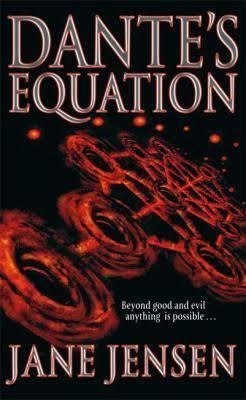7.4 /10 1 Votes7.4
Language English Pages 496 pp OCLC 52742526 | 3.7/5 Goodreads Publication date July 29, 2003 ISBN 0-345-43037-9 Originally published 29 July 2003 Country United States of America | |||||||||||||||||||||||||||||||||
 | ||||||||||||||||||||||||||||||||||
Media type Print (hardback & paperback) Similar Jane Jensen books, Science Fiction books | ||||||||||||||||||||||||||||||||||
Dante's Equation is a novel written by Jane Jensen and published in 2003. It was nominated for the Philip K. Dick Award and received a Special Citation for it.
Contents
Plot summary
The novel tells the discovery of many people, two of them physicists, that the fifth dimension obeys a (species of spiritual) law of nature where Good and Evil control the lower dimensions. This insight was first discovered by a Jewish physicist, Yosef Kobinski, who was interned in Auschwitz during the Holocaust. It is rediscovered by Dr. Jill Talcott and her graduate-student assistant. Talcott's discovery coincides with the resurfacing of manuscripts written by the Jewish physicist. The discovery and the manuscripts attract an interest from several sources. A kabbalistic scholar becomes interested in Kobinski as well, as his name shows up in an analysis of Torah codes. A journalist is trying to track down Kobiniski too as part of the research for an article on disappearances. The military become aware of the phenomenon as well, and one agent tries to track down the young scientist and her partner in order to evaluate the military applications of the discovery.
Characters
Themes
Literary significance and reception
Jeff Zaleski gave this novel a mixed review for Publishers Weekly, saying, "Jensen is on surer ground describing Kabbalah and Holocaust history than she is plotting supernatural adventures, which unravel by the end. But she gets points for the innovative, multifaceted story." Frieda Murray was more positive in her review for Booklist, saying, "The book plays out as it has begun, in rather standard thriller fashion. Jensen keeps it moving, though, and her characters, if not always sympathetic, are fully developed. In this, her second novel, she gives lessons in style to many thriller writers with longer publication lists." Kirkus Reviews was also somewhat mixed in their summary, describing the novel as "intriguing and often surprising, but what with a plot that doesn't add up and (with one exception) a nasty bunch of characters: mostly a tough slog."
Marian Kester Coombs in her review for Human Events was much more positive, saying, "the writing is felicitous--sometimes humorously colloquial, sometimes Virginia-Woolfish in the subtlety of its aperçus--and the momentum is energetic throughout (too often such heady plots lose steam and end up chugging wearily into the station for the obligatory finale). The wide range of believable (and mostly likable) characters remains alive and kicking. Jensen is particularly good at animating male characters, but her Dr. Jill Talcott is a memorable creation here."
Fiona Kelleghan gave the novel a rave review in The Washington Post, saying that Jensen writes "confidently and enthrallingly" and that the novel "deserves to take its place...in a Hugo nomination line-up": "Babe scientist Jill Talcott and her delightful lab assistant Nate stumble onto an equation with literally world-shaking implications, and their unexpected alliance with a playboy tabloid journalist and an Orthodox rabbi endangers all four and their murderous Department of Defense pursuer. Equally assured at mathematical speculation and kabbalistic cosmology, the novel is fast-paced, suspenseful, and a joy from beginning to end."
Victoria Strauss of the SF Site thought that the novel "has more the feel of a thriller than science fiction" but that "Not so many thrillers, either, are as character-driven as this one. ... Fast-paced, suspenseful, and intellectually engaging, Dante's Equation is thoroughly enjoyable reading. Anyone who was tempted to hurl Dan Brown's wooden and overhyped The Da Vinci Code across the room might want to give this book a try; if you're looking for a well-written thriller full of religious symbology and exciting action, this is the real thing."
Jane Jensen described the book a critical and commercial disappointment.
